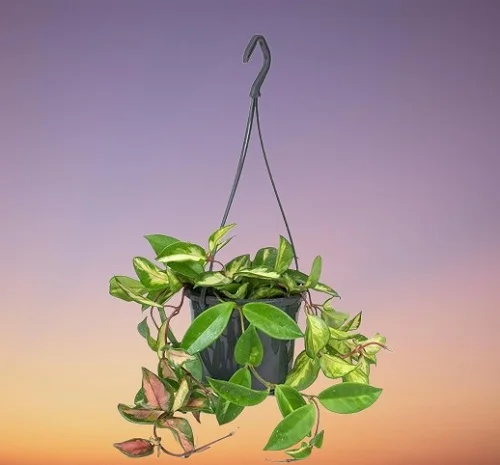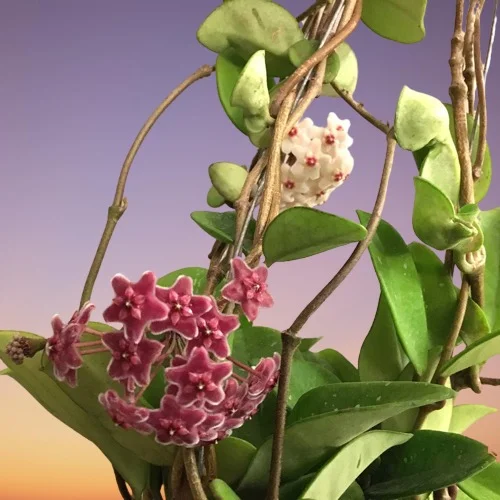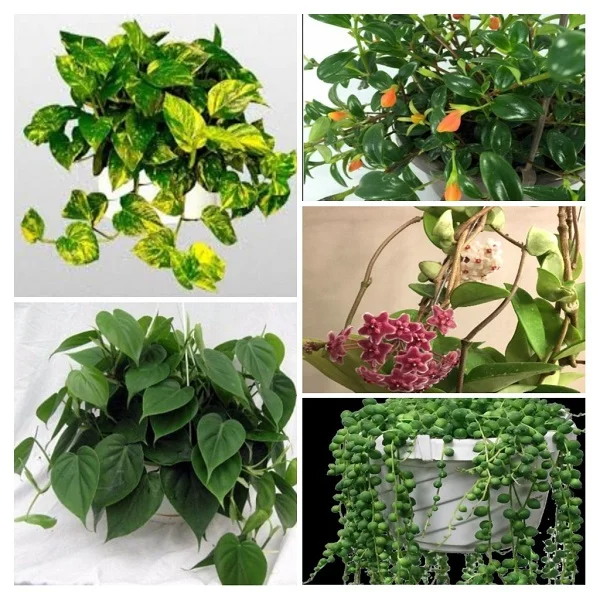How to Grow, Care and Propagate Wax Plant (Hoya carnosa) Indoors
Some links in this post may be affiliate links
Wax Plant (Hoya carnosa) thrives in bright light with some direct sunlight, average warmth, moderate humidity and moderately moist, rich, well-drained hoya potting soil coupled with monthly feeding in the growing season.
Hoya carnosa also called Porcelainflower is one of the popular flowering plants and bears fleshy leaves and clusters of waxy, fragrant, star-shaped flowers.
The twining stems can reach 15 feet or more making it ideal for a hanging basket or a trellis. The leaves are heart-shaped and fleshy with a glossy surface.
Care for Hoya carnosa is easy if the don'ts are observed. Some of these are don't disturb the plant once the buds appear as change in light intensity may cause them to drop.
Don't remove the dead flowers as new flowerbuds will form in the spurs. Don't repot until it is unavoidable as being root-bound encourages flowering. It benefits from loose potting medium that allows some air to get to the roots.

Botanical name: Hoya carnosa
Family: Apocynaceae
Subfamily: Asclepiadoideae
Common names: Wax Plant, Porcelainflower
Origin
Hoya carnosa is native to Eastern Asia and Australia where it grows as an epiphyte, climbing on trees in the humid subtropical forests.
Air Cleaning
Studies carried out at the University of Georgia have shown that Hoya carnosa is good at getting rid of pollutants from indoor air.
Varieties
Many cultivars of Hoya carnosa have been developed which vary in foliage form or flower color. Some of these cultivars include;
Hoya carnosa 'Compacta' or Hoya carnosa 'Krinkle Kurl commonly called Hindu Rope which bears curly twisted leaves on the stems which hang downwards.
Hindu Rope Hoya has a variegated cultivar, ‘Mauna Loa’, whose green leaves are cream to pinkish in the center.
Hoya carnosa ‘Krinkle 8’ has dimpled leaves. The '8' is in reference to the number of dimples in the leaf. It is similar to Hoya carnosa ‘Chelsea’ which has 6 dimples and Hoya carnosa ‘Krinkle 8 Variegata’ whose leaves are cream-edged.
Hoya carnosa ‘Argentea Picta’ which bears rounded, silvery-green leaves, with cream edges.
Hoya carnosa ‘Argentea Princess’ which is similar to Hoya carnosa ‘Argentea Picta’ but the cream variegation is on the inside of the leaves.
Hoya carnosa 'Krimson Queen' also called Hoya carnosa 'Tricolor' whose leaves start off with pinkish variegation on the edges which turns cream as they mature.
Hoya carnosa 'Krimson Princess' also called Hoya carnosa 'Rubra' with leaves which are pinkish to cream in the center and green along the edges.
Hoya carnosa ‘Freckles’ also called Hoya carnosa ‘Freckles Splash’ which has fine silver markings on the dark-green leaves.
Is Hoya carnosa poisonous?
Yes. Hoya carnosa produces a milky white sap which contains latex. The latex is considered to be toxic to humans and pets. Always wear gloves when handling this plant and keep it from the reach of children and pets.
Where to Buy
If you are looking to add Hoya carnosa to your collection, you may obtain them online from Amazon (Link to Amazon).
How do you care for Hoya carnosa indoors?
To care for Hoya carnosa indoors, provide bright light with 4-6 hours of direct sunlight, warmth of 16-260C, humidity of 50-55% and moderately moist, rich, well-drained hoya potting soil coupled with monthly feeding during the growing season.
Wax Plant care requires pruning to keep it neat, minimize pests and encourage a bushy compact growth. Repotting is needed only when it becomes extremely pot-bound as it blooms best when root-bound. Keep reading for more on these growing conditions and how to achieve them.

Light Requirements
Wax Plant grows best in bright light with 4-6 hours of morning or late afternoon sunshine. Do not expose it to hot midday sunshine to prevent scorching of the leaves.
Hoya carnosa can adapt to lower light levels but it will become leggy and will not bloom if the light is not enough. Where the natural lighting is not adequate, consider installing a grow light to supplement it.
Rotate the pot regularly to make sure that the plant receives light on all sides for a balanced growth and to prevent legginess.
Watering
Water your Wax Plant liberally in spring and summer while allowing the top 2-3 inches of soil to dry out between waterings. Keep the soil moderately moist and avoid overwatering to prevent rotting, yellowing, browning and leaf drop.
Lessen watering in fall and winter to maintain the soil slightly moist as growth is minimal at this time. Do not let the soil dry out completely to prevent wilting and shriveled leaves, yellowing, browning and leaf loss.
Use room temperature water to prevent cold shock which can result in stunted growth and leaf fall. Ascertain that the water is free of dissolved chemicals like chlorine and flourides to prevent browning of leaves. You may use rain water or filtered water.
Ensure that the pot has a drainage hole and the soil is well-draining to prevent waterlogging which can lead to root-rot and eventual loss of the plant.
Take care not to wet the foliage during watering to minimize fungal diseases; you may water from the bottom instead. Do not disturb a plant that is in flower as it can shorten the flowering period.
Temperature & Humidity
Hoya carnosa flourishes in an average warmth of 16-260C. Keep it away from sources of drafts like AC units, hot air vents, stoves, drafty windows, windy doors and others to prevent sudden changes in temperature which can cause reduced growth, yellowing, and leaf and flowerbud drop.
Wax Plant has no need for extra humidity; a humidity of 50-55% is ideal for this plant. Do not mist the plant to avoid wetting the flowers to prevent rotting. Maintain a good air circulation to discourage fungal diseases.
Fertilizer
Feed your Wax Plant with a phosphorous-rich, water-soluble fertilizer every 4 weeks in spring and summer to promote flowering and a lush growth.
Do not feed in fall and winter to prevent fertilizer burn (browning of leaf tips and edges) as growth is minimal at this time.
Occasionally leach out accumulated salts by running a stream of water through the soil until it drains through the drainage hole. Repeat the process several times to clean out as much salt as possible.
Potting Soil
The best soil for Hoya carnosa is a rich, loose, well-draining soil to prevent waterlogging while providing the required nutrients. Potting mixes designed for Hoya plants are ideal for this plant.
Repotting
Repot your Wax Plant at the beginning of the growing season (spring to early summer), only when extremely pot-bound as it blooms best when slightly root-bound. Do not repot a Hoya Plant that is in the flowerbud formation stage as it can drop the buds.
Select a pot 1 size larger that has a drainage hole to prevent the soil from getting soggy to avoid root-rot and eventual death of the plant. Take a look at these ceramic pots with drainage holes on Amazon.
Pruning & Grooming
Pruning Wax Plant involves:
- Removal of the dead leaves to maintain the plant neat and discourage pests and diseases. Don't remove the dead flower stalks as more flowers will form from the spurs.
- Cutting back the stems after flowering to rejuvenate growth and to prevent the plant from becoming unruly.
Regularly clean the leaves by damp wiping with a soft cloth to get rid of dust as well as discourage pest and disease infestations.

Wax Plant Propagation
Wax Plant is best propagated from stem cuttings or by air layering at the beginning of the growing season (spring to early summer) when in active growth.
1. Hoya carnosa propagation from stem cuttings
- Take 4-5 inches stem cuttings from a healthy plant. Ensure each cutting bears at least 2 leaf nodes and 1 set of leaves.
- Fill small pots with well-draining soil and moisten it slightly. Use a pot with a drainage hole to prevent rotting.
- Insert 1-2 inches of the lower cut-end of the stem cuttings in moist soil.
- Position the pots in a warm, well-lit spot away from direct sunlight to prevent scorching.
- Maintain the soil moist through out until the new plants are well established after which you can begin routine care.
2. Hoya carnosa propagation by air layering
- Make a cut (notch) on the stem of a healthy plant, coat the notch with a rooting hormone and surround the area with damp moss.
- Cover the notched area with a polythene film or clear plastic wrap and maintain moist until roots develop.
- After the roots have formed sever the stem just below the covered part, remove the polythene and carefully pot the rooted cutting.
- Place the set up in a warm, well-lit place away from direct sunlight to avoid scorching.
- Maintain the soil moist until the new plant is well established after which you can begin routine care.
Hoya carnosa Problems Indoors
Hoya carnosa (Wax Plant) problems are yellow leaves, brown leaves, plant dying, leaf drop, shriveled leaves, flowerbud drop, lack of blooms, pests and diseases among others.
Learn more on these 12 Hoya Plant Problems and How to Fix Them.
You liked it? Share on social media.
Related Content
Amazon Associates Disclosure
Homeplantsguide.com is a participant in the Amazon Services LLC Associates Program, an affiliate advertising program designed to provide a means for sites to earn advertising fees by advertising and linking to amazon.com.


